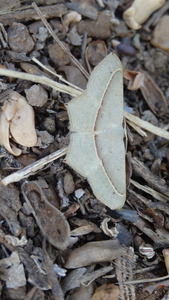
Acacia s.l., known commonly as mimosa, acacia, thorntree or wattle, is a polyphyletic genus of shrubs and trees belonging to the subfamily Mimosoideae of the family Fabaceae. It was described by the Swedish botanist Carl Linnaeus in 1773 based on the African species Acacia nilotica. Many non-Australian species tend to be thorny, whereas the majority of Australian acacias are not. All species are pod-bearing, with sap and leaves often bearing large amounts of tannins and condensed tannins that historically found use as pharmaceuticals and preservatives.
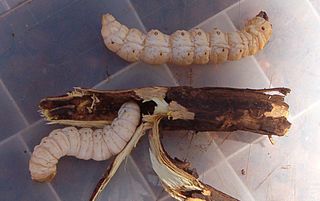
The witchetty grub is a term used in Australia for the large, white, wood-eating larvae of several moths. In particular, it applies to the larvae of the cossid moth Endoxyla leucomochla, which feeds on the roots of the witchetty bush that is widespread throughout the Northern Territory and also typically found in parts of Western Australia and South Australia, although it is also found elsewhere throughout Australia.
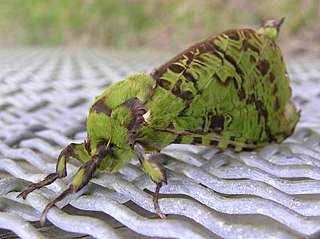
Aenetus is a genus of moths of the family Hepialidae. There are 24 described species found in Indonesia, New Guinea, New Caledonia, Australia and New Zealand. Most species have green or blue forewings and reddish hindwings, but some are predominantly brown or white. The larvae feed in the trunks of living trees, burrowing horizontally into the trunk, then vertically down.
Eumeta crameri is a bagworm moth of the family Psychidae. It was described by John O. Westwood in 1854 and has worldwide distribution in tropical and subtropical habitats, including India, Bangladesh, Sri Lanka, New Zealand and Puerto Rico.

Thalaina clara, or Clara's satin moth, is a moth of the family Geometridae. The species was first described by Francis Walker in 1855. It is endemic to south-eastern Australia.
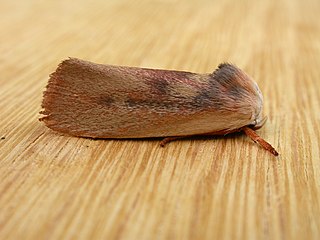
Cryptophasa rubescens is a moth of the family Xyloryctidae. It is found in Australia, where it has been recorded from New South Wales, Queensland and Victoria.
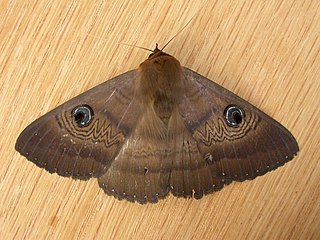
Dasypodia selenophora, the southern old lady moth, is a moth of the family Noctuidae. The species was first described by Achille Guenée in 1852. It is found in the southern half of Australia, as well as Norfolk Island, New Zealand and Macquarie Island.

Anthela nicothoe, the urticating anthelid, is a moth of the family Anthelidae.

Pholodes sinistraria, the sinister moth or frilled bark moth, is a moth of the family Geometridae. The species was first described by Achille Guenée in 1857. It is found in the eastern parts of Australia.

Cometaster is a monotypic moth genus of the family Erebidae erected by George Hampson in 1913. Its only species, Cometaster pyrula, the faint owl moth or ying-yang moth, was first described by Carl Heinrich Hopffer in 1857.

Speiredonia spectans, the granny's cloak moth, is a moth of the family Erebidae. The species was first described by Achille Guenée in 1852. It is found in north-eastern Australia and Tasmania. Strays have been recorded on Norfolk Island and in New Zealand.
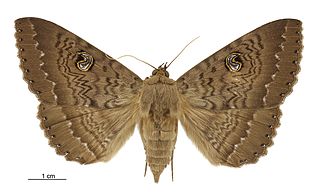
Dasypodia cymatodes, the northern old lady moth or northern wattle moth, is a moth of the family Noctuidae. The species was first described by Achille Guenée in 1852. It is found in Australia, and is self introduced in New Zealand.

Traminda is a genus of moths in the family Geometridae described by Saalmüller in 1891.

Cryptophlebia ombrodelta, the litchi fruit moth or macadamia nut borer, is a moth of the family Tortricidae. The species was first described by Oswald Bertram Lower in 1898. It is native to India, Sri Lanka, Nepal, Indonesia, China, Taiwan, Vietnam, Thailand, western Malaysia, New Guinea, the Philippines, Japan, Guam, the Caroline Islands, Australia and has been introduced to Hawaii.

Protuliocnemis biplagiata is a species of moth of the family Geometridae first described by Frederic Moore in 1887. It is found in Indo-Australian tropics east to New Caledonia.

Cryptophlebia illepida is a species of moth in the family Tortricidae that is endemic to the islands of Kauaʻi, Oʻahu, Molokaʻi, Maui, Lānaʻi and Hawaiʻi. Common names include koa seedworm, klu tortricid, koa seed moth, litchi borer, litchi moth, macadamia nut borer and macadamia nut moth. It was first described by Arthur Gardiner Butler in 1882.
Ericeia elongata is a moth in the family Erebidae. It is found from the Indo-Australian tropics to New Guinea and Australia (Queensland). The habitat consists of lowland forests, including heath and alluvial forests.

Uromycladium is a genus of rust fungi in the family Pileolariaceae. It was circumscribed by mycologist Daniel McAlpine in 1905. The genus was established by McAlpine for rusts on Acacia with teliospores that clustered at the top of a pedicel.

Uromycladium tepperianum is a rust fungus that infects over 100 species of Acacia and related genera including Paraserianthes in Australia, south-east Asia, the south Pacific and New Zealand. The acacia gall rust fungus species Uromycladium tepperianum has been introduced to South Africa as a biological control on the invasive Australian shrub Acacia saligna.

Traminda aventiaria, the cross-line wave moth, is a species of moth in the family Geometridae. The species was first described by Achille Guenée in 1858. It is found in the Indian subregion, Sri Lanka, to Hong Kong, Taiwan, New Guinea and Australia.
